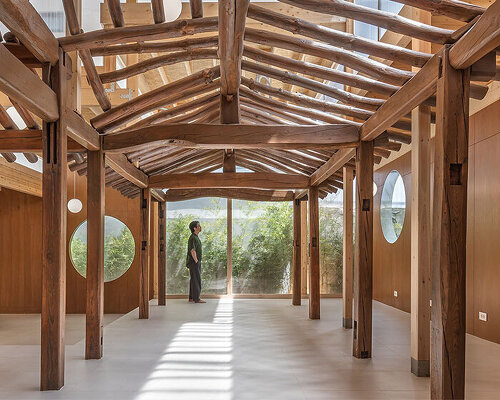DRAWING WORKS’ Revamp Weaves Memory, Material, & Movement
At the intersection of a boulevard and a backstreet in Seoul, architecture studio DRAWING WORKS reimagines a site where two buildings from different eras— a 1949 hanok and a five-story concrete commercial structure extended in 1968—stand side by side. Rather than preserving or replacing, the studio superimposes contemporary elements onto the existing fabric, creating a layered dialogue between past and present. Key architectural features of the renovation project, dubbed Giwa, include a modular metal facade on the commercial building that reinterprets the rhythm of traditional hanok roofs, a luminous hanok interior animated by light and spatial voids, and an exterior stairwell inserted like a narrow alleyway to stitch the two structures together. Together, these interventions establish a rich interplay of memory, material, and movement—threads unraveled in the sections that follow.
all images courtesy of DRAWING WORKS
a Stairwell, a Metal Facade, and a Light-Filled Hanok
Between the two buildings, architecture studio DRAWING WORKS has inserted a narrow stairwell designed to function more like an alleyway than a conventional circulation space. This mediating void channels movement, light, and the layered textures of the city. Evoking the slim alleys of old Seoul, the stairwell stitches together the hanok and its concrete neighbor while establishing a spatial rhythm that blurs the boundary between architecture and urban life.
The commercial building, W1, presents a striking façade to the street. Modular metal panels reinterpret the wave-like rhythm of hanok tiled roofs, transforming historical reference into a contemporary expression. Factory-fabricated and quickly assembled, the panels offer both construction efficiency and visual richness—subtly embedding memory into the modern streetscape. In contrast, the renovated hanok, W2, is inward and luminous. The Korean studio preserved the original wooden structure wherever possible, while carefully placed gaps allow light to filter through the layered roofs and deep into the interior. These voids do more than illuminate; they create a quiet dialogue between structure, atmosphere, and the passing of time, inviting the city’s rhythms to gently permeate the space.
the project is characterized by luminous hanok interiors
the space is animated by light and spatial voids
the renovated hanok is inward and luminous
the original wooden structure is preserved wherever possible
carefully placed gaps allow light to filter through the layered roofs
the voids create a quiet dialogue between structure, atmosphere, and the passing of time
project info:
name: Giwa
architect: DRAWING WORKS
location: Seoul, Korea
The post illuminated hanok interior meets modular facade in drawing works’ seoul renovation appeared first on designboom | architecture & design magazine.

